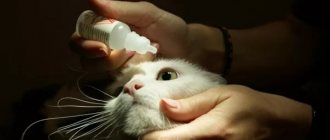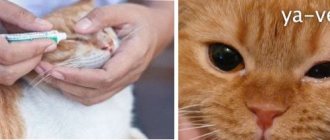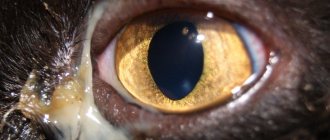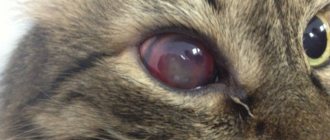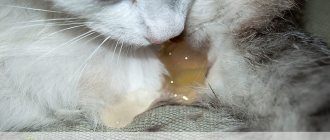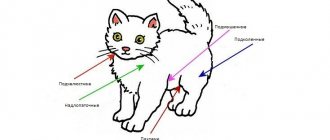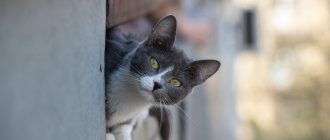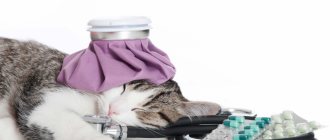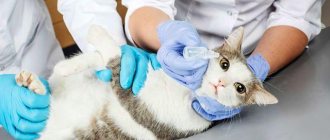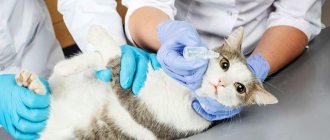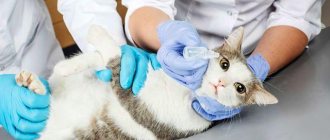For various reasons, cats' eyes often begin to fester. This may indicate either an eye disease or a serious illness in the animal. The owner of every pet should know how to treat a cat and how to find out the cause of eye infection.
If you don’t know how to treat a cat’s eyes, then read this article.
In this article, you will get acquainted with the most common causes of eye suppuration and methods of treating this disease.
Causes of eye infection in cats
Cats' eyes can fester for various reasons, and here are the most common ones:
- Conjunctivitis is the most common cause of eye infection in animals. This disease is very easy to cure; the most important thing is not to let it get worse.
- Trauma to the mucous membrane can also cause suppuration of the eye. Small wounds on the animal heal on their own, but larger ones should be treated.
- Blepharitis is a dangerous eye disease in cats that can occur as a result of a chemical burn or injury.
- Keratitis is an inflammation of the cornea that leads to suppuration of the eye.
- Due to poor health and low immunity, the animal's eyes may fester.
- Also, cats' eyes can fester due to poor nutrition.
- As a result of a “dirty nest”, the cat’s eyes may fester.
- If the kitten is hypothermic, it may develop purulent discharge from the eyes.
- Heredity.
Features of the procedure
Whether a cat requires treatment or a kitten, there are no significant differences in treatment procedures.
In both the first and second cases, accuracy and calm are required. Animals, not understanding what is happening to them, begin to get nervous, fidget and may even try to bite.
To make the process safer, you can use a special bag-retainer (these are sold in pet stores), or an ordinary thick blanket in which you can wrap the cat, leaving only its head free.
Materials you will need:
- sterile gauze or cotton pads;
- clean towel or cloth napkins;
- syringe or pipette;
- the drug itself.
In adults
- It will be great if you involve an assistant in the matter. He will be able to fix the animal in the desired position, and you will calmly and without distraction carry out all the necessary manipulations. The animal is placed in a retaining bag or wrapped in a blanket, hiding its paws and claws away.
- Wash your hands thoroughly with soap.
- Dry crusts in the corners of the eyes or on the eyelids should never be peeled off - only soaked and carefully peeled off little by little. Ordinary clean water will help soften them: moisten a cotton swab generously, press it to the eye and hold, and when the crusts become noticeably softer, slowly peel them off. Do not pour water into your cat's eyes unnecessarily, do not rub the cornea, and follow a line from the ears to the nose along the tear duct. Use a separate clean pad for each eye.
- If during rinsing you notice foreign, indelible particles lying on the surface of the eye or in the folds of the conjunctiva, do not touch them and do not try to remove them yourself, immediately run to the doctor!
- Are your eyes clear? Excellent: you can wash it with medicine. To do this, use either a regular human pipette, a syringe, or a 20 ml syringe (without a needle, of course). Spread the eyelids with two fingers (index and thumb) and drip the solution into the upper outer corner of the eye: this way the solution will thoroughly wash the entire cornea and conjunctival sac. The remaining solution is blotted with a napkin or towel.
Do not rub the cornea with a cloth, do not press on it - this can cause grass to the animal.
In kittens
Unlike adults, kittens cannot perform a full toilet until a certain age: their mother cat takes care of them for a long time and the babies need time to get used to doing everything on their own.
Therefore, if problems begin with the kittens’ eyes, and the mother cat is not nearby, you will have to deal with it yourself. Proceed in the same way as with adult animals. But even more care and attention is needed, because kittens’ eyes are smaller and more vulnerable than those of adults.
You don’t need to involve an assistant here: you can handle the baby yourself. The most convenient time is after sleep, when the baby has not yet played out, or before bed. You cannot carry out the procedure immediately after eating - the kitten may vomit.
If, in addition to cleansing rinses, you will also need to apply ointments, wait 10 minutes after the procedure. This minimizes the risk of mucosal irritation.
If you have never washed your animal’s eyes and, in general, be afraid to carry out any medical procedures - contact your nearest veterinary clinic. They will take a little money for this, but they will do everything quickly and carefully, and they will also give useful advice for the future.
Symptoms of a pet's disease
When a pet gets sick, accompanying symptoms immediately appear. If the owner notices one or more of the following signs of disease in the kitten, he needs to urgently contact a veterinarian.
- The pet has become aggressive and angry, very often rubbing its eyes with its paw:
- The kitten refuses to eat and sleeps poorly;
- In the light, the pet closes its eyes and tries to stay in a dark corner;
- Increased body temperature;
- The eyes water, become red, and purulent formations flow out of them;
- The fur takes on a brownish tint after about a century.
Symptoms
When the owner detects the following signs, he should be alert in order to promptly determine the cause and begin treatment:
- The animal rubs its eye with its paw, it becomes aggressive and restless.
- Lack of appetite, refusal to eat.
- Fear of light can be determined by such signs as preference for a dark corner; while in the light, the cat tries to close its eyes.
- Fever.
- The eyes become red, watery, and pus is released.
- The fur, which is about a century old, has a brown tint.
Treatment of eye suppuration according to the recommendations of a veterinarian
Once the veterinarian determines the cause of the pus discharge from the pet's eyes, he will prescribe the appropriate treatment.
- If the kitten develops swelling, then in this case it is necessary to use a solution of hydrocortisone and novocaine.
- If the pet experiences severe pain, then it is necessary to use a novocaine blockade with an antibiotic. This drug can not only reduce pain, but also relieve the inflammatory process.
- If an animal has an advanced disease, the veterinarian will prescribe a course of antibiotic therapy by injection.
- If pus is released from the eyes after an injury or a foreign object, then the animal must use drops of Levomycetin or Iris.
Any of the above drugs should be used only after consultation with a veterinarian. Self-medication can cause the kitten to lose sight.
Suppuration: normal or pathological?
Eye discharge does not always appear due to pathological processes developing in the body.
In some cases, pus in a cat accumulates under the eyelids for the following reasons:
- weakened immune system;
- improperly selected diet (lack of nutrients);
- infectious, viral damage;
- unsanitary conditions when keeping animals;
- draft;
- eye injuries;
- allergic reaction to household chemicals, perfumes;
- inflammatory processes in the cornea (keratitis);
- dust in the room where the pet is kept.
On a note! If the discharge is abundant and prolonged, you should not resort to self-medication; the animal must be taken for examination to a veterinary clinic, where the doctor will determine the cause and prescribe adequate treatment.
The owner should pay attention to the color of the discharge. Rare discharge of a grayish tint is normal, and thick discharge of a yellowish or green tint most likely indicates the development of pathological processes in the body.
First aid for a pet at home
There are situations when it is impossible or very difficult to get to the veterinarian. In this case, the owner must provide first aid to his pet.
- Washing your eyes is a very important aspect. By washing your eyes, you relieve your baby's suffering. Eyes should be washed only with a warm solution using a cotton pad. After rinsing, your pet should apply an eye ointment, such as tetracycline.
Washing is performed by the following means:
- A decoction of medicinal chamomile;
- Boric acid solution;
- 0.02% furatsilin solution.
- Eye ointment. Before applying the ointment, you need to warm it in your hand. Cold ointment should never be applied to the affected area. The ointment should be applied as follows:
- The kitten should be placed on its side and held tightly. It is best if one person holds the pet while the other applies the medicine.
- Next, you need to carefully pull back the lower eyelid and gently apply the ointment.
- Then, you should massage the eyelid so that the medicine is distributed over the eye.
- You can also put special drops in your pet’s eyes. Which ones you need to find out at your veterinary pharmacy.
Suppuration with a runny nose, what to do
Eye discharge accompanied by chills, sneezing, and snot most often indicate a runny nose. For a fragile body, a runny nose can serve as an impetus for the development of serious diseases, such as viral rhinotracheitis or calcivirosis.
If you suspect the development of the disease, you should take the animal to a veterinary clinic, where a doctor will examine it, prescribe tests and a treatment regimen.
Medicines that are most often prescribed for colds to treat suppuration:
- anti-inflammatory drugs,
- antibiotics,
- immunomodulators.
Disease prevention
In order for your pet to get sick less often, he needs to take preventive measures, namely:
- A small pet should wash its eyes daily;
- When playing with an animal, it is necessary to take all measures so that the kitten does not get injured;
- All vaccinations must be done on time;
- The animal's nutrition must be correct and balanced;
- Take your pet to the vet regularly.
Caring for your pet is a very important aspect of pet care. After all, this is the only way your baby will grow up healthy and happy.
What drops and ointments to use
For ocular discharge, veterinarians advise using various ointments and drops for treatment. In order for the drug to be beneficial, the owner must follow a number of rules.
How to instill drops:
- Pre-rinse the eye mucosa with herbal decoction or tea leaves.
- Secure the pet and lay it on its side.
- Pipette drops at room temperature.
- Gently drip into outer corners.
- Remove residues with a dry cotton pad.
Be sure to read:
The cat eats poorly and constantly sleeps, is lethargic: normal or pathological, the reason, what to do when you need help
How to apply the ointment:
- Warm the prescribed drug in your palms to room temperature.
- Secure the pet with a towel and lay it on its side.
- With clean hands, place the ointment under the lower eyelids, pulling them slightly.
- Massage the eyelids with the ointment for a few seconds.
- Rub the treated eyes with a dry cotton swab to remove excess.
Commonly prescribed ointments:
- tetracycline eye ointment,
- hydrocortisone,
- solcoseryl.
Popular drops:
- albucid,
- gentamicin drops,
- veterinary drops “Iris”, “Bars”, “Diamond Eyes”,
- levomecithin drops.
Conjunctivitis
This is an inflammation of the outer layer of the eye, which is normally pink in color.
Symptoms:
- Redness of the eye,
— Discharge (can be transparent in the form of a tear, mucous, purulent)
- Squinting of the eye, local itching.
Treatment:
1. Use of local and systemic antibiotics and antiviral, and, if necessary, local antiallergic drugs.
============================================================================================================================================================================================
Diagnostics
When a kitten’s eye festers, the doctor decides how to treat it. Modern diagnostic procedures do not take much time and do not cause discomfort to the animal.
Before visiting the doctor, it is better not to feed the kitten, as the veterinarian may order a laboratory blood test.
On the day of visiting the clinic, kittens do not wash their eyes - this will blur the overall picture of the discharge and make it difficult to make an accurate diagnosis.
The reasons why a cat’s eye is watery or purulent are determined using the following methods:
- Schirmer's test - determines the amount of tear fluid that is necessary to maintain the natural level of humidity;
- biomicroscopy – studies the condition of the connective membrane, iris, vitreous body, lens;
- measurement of intraocular pressure - the difference between the addition and outflow of moisture is determined;
- Ultrasound – examination of all structures of the organ of vision;
- examination of the optic nerve and retina;
- checking the patency of the nasolacrimal ducts.
Uveitis
Inflammation of the iris and ciliary body - structures located inside the eye.
Symptoms:
- Squinting, redness and clouding of the eye.
- Constriction of the pupil.
— Precipitates on the corneal endothelium (small white dots on the inner surface of the cornea)
— Exudate (effusion) in the anterior chamber of the eye
- Decrease in intraocular pressure.
Treatment:
1. Local corticosteroids, non-steroidal anti-inflammatory drugs, mydriatics and systemic drugs.
===========================================================================================================================================================================================
